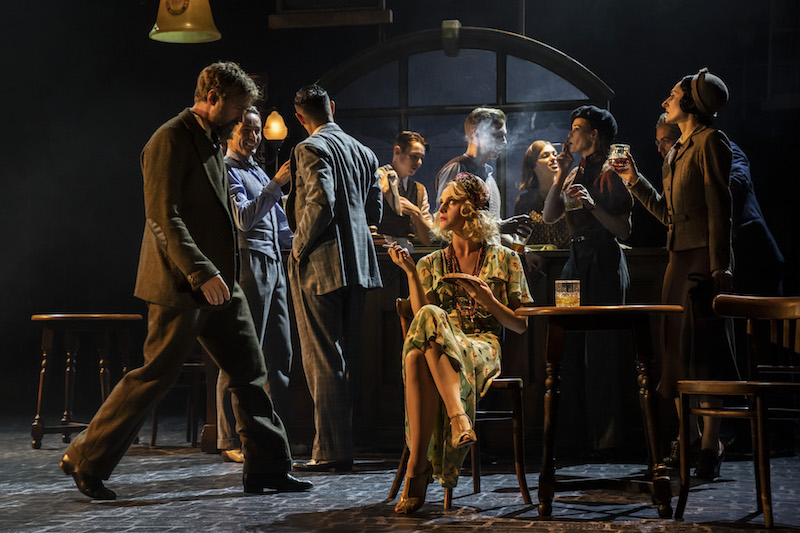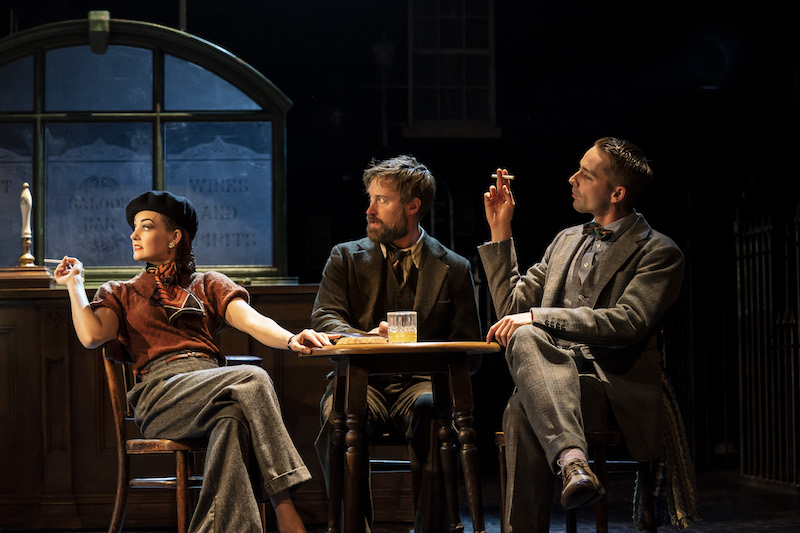The Midnight Bell, New Adventures, Sadler's Wells review - dance theatre at its most compelling | reviews, news & interviews
The Midnight Bell, New Adventures, Sadler's Wells review - dance theatre at its most compelling
The Midnight Bell, New Adventures, Sadler's Wells review - dance theatre at its most compelling
Matthew Bourne hits his stride in an engrossing picture of lovelessness in 1930s London

The British author Patrick Hamilton is best known for two highly successful plays, Rope (1929) and Gaslight (1939), which in turn became highly successful films. But it’s Hamilton’s novels, set among the fog-bound pubs and clubs of 1930s Soho, that have inspired Matthew Bourne’s latest enterprise, The Midnight Bell.
The lack of a synopsis in the programme booklet is at once surprising and encouraging. Too much dance-theatre is sunk by the dead weight of printed explication, and really, if a story can’t be told in movement, it’s probably the wrong story. The show takes its title from a pub, The Midnight Bell being one of several down-at-heel locations frequented by the 12 characters, most of them drawn directly from Hamilton’s novels and all of them, in their different ways, lost souls in search of human warmth.
 This is the flipside of Noel Coward’s smart society. Daisy May Kemp’s actress character is out of work, depressed and regularly drunk, while Richard Winsor’s schizophrenic suffers appalling tinnitus and sleeps on a park bench. Michela Meazza’s lonely spinster is prey to any passing spiv, and Andrew Monaghan’s bobby on the beat turns out to have a dangerous secret. These and other characters (pictured above) are presented to us at the outset with a novelist’s touch: they mill about, they pass in the street or public bar. It’s unclear for some time what relationship, if any, one has to another, and when a web of connections does gradually come into focus, it quickly unravels and re-tangles. All this without a word being spoken, unless you include the occasional breaking out of character into popular song (Pennies from Heaven style, mimed), an idea which has surprising charm, and can turn funny, or sardonic or tragic.
This is the flipside of Noel Coward’s smart society. Daisy May Kemp’s actress character is out of work, depressed and regularly drunk, while Richard Winsor’s schizophrenic suffers appalling tinnitus and sleeps on a park bench. Michela Meazza’s lonely spinster is prey to any passing spiv, and Andrew Monaghan’s bobby on the beat turns out to have a dangerous secret. These and other characters (pictured above) are presented to us at the outset with a novelist’s touch: they mill about, they pass in the street or public bar. It’s unclear for some time what relationship, if any, one has to another, and when a web of connections does gradually come into focus, it quickly unravels and re-tangles. All this without a word being spoken, unless you include the occasional breaking out of character into popular song (Pennies from Heaven style, mimed), an idea which has surprising charm, and can turn funny, or sardonic or tragic.
Bourne allows these characters two principal forms of movement, beyond everyday walking about. One is danced movement that expresses their inner thoughts and feelings, alone or with another character; the other is social dancing. He has long been a master of both, and it’s a particular joy to spot the dance forms he alludes to in the latter mode. While one couple seem to be doing a foxtrot-cum-tango and another pair incorporate comically camp ballet tendus, the spinster defaults to the Charleston which was fashionable several years before. In every case the performers – many of them veterans of Bourne’s 27-year-old company New Adventures – are flawless. I particularly enjoyed the virtuosity of Paris Fitzpatrick as Bob, the pub waiter, dancing alone in his bedsit with a pillow as substitute partner, spinning like a top and diving repeatedly over his unmade bed. Although all the characters are basically unhappy, joy persists in erupting through the cracks.
Bourne’s creative collaborators are key to this success. It’s thanks to the subtleties of Paule Constable’s lighting that we accept the visual conceit of two couples occupying the same bedsit space (and sometimes the same bed) and understand that they are in two separate bedsits. Fans of Bourne’s early work may recall his first experiment in what might be called shared space in the brilliant Play Without Words. It’s the compact scale of The Midnight Bell that has allowed him to build on those ideas.
Set designer Lez Brotherston – whose signature style has been much copied but rarely matched – is now so adept at his own shorthand that a few floating sash windows, a street lamp and the roof of a red telephone box (no actual kiosk, just the top part) can conjure a 1930s street in less time than it takes to flick the ash from a Woodbine. Meanwhile Terry Davies negotiates the musical gulf between his contemporary score (typically building up layers of highly rhythmic tuned percussion) and the period pop songs that pepper the evening, many of them re-recorded to suit his purposes, complete with 78rpm crackle.
 While it might seem odd, post-Covid, for Bourne to choose such a downbeat scenario, homing in on unhappy lives that largely remain so, the ultimate effect is uplifting. This can only be down to the warmth and sympathy Bourne and his performers bring to their subjects, not to mention inspiration and skill. There is a scene which finds the characters in a fleapit cinema watching a dance-musical featuring unrelenting twosome bliss. In extracting the essence of the gritty world of Hamilton's novels and – ironically – framing it as his own kind of dance-musical, Bourne counters that romantic lie. The Midnight Bell is utterly compelling and the best new work I’ve seen in ages.
While it might seem odd, post-Covid, for Bourne to choose such a downbeat scenario, homing in on unhappy lives that largely remain so, the ultimate effect is uplifting. This can only be down to the warmth and sympathy Bourne and his performers bring to their subjects, not to mention inspiration and skill. There is a scene which finds the characters in a fleapit cinema watching a dance-musical featuring unrelenting twosome bliss. In extracting the essence of the gritty world of Hamilton's novels and – ironically – framing it as his own kind of dance-musical, Bourne counters that romantic lie. The Midnight Bell is utterly compelling and the best new work I’ve seen in ages.
The future of Arts Journalism
You can stop theartsdesk.com closing!
We urgently need financing to survive. Our fundraising drive has thus far raised £49,000 but we need to reach £100,000 or we will be forced to close. Please contribute here: https://gofund.me/c3f6033d
And if you can forward this information to anyone who might assist, we’d be grateful.

Subscribe to theartsdesk.com
Thank you for continuing to read our work on theartsdesk.com. For unlimited access to every article in its entirety, including our archive of more than 15,000 pieces, we're asking for £5 per month or £40 per year. We feel it's a very good deal, and hope you do too.
To take a subscription now simply click here.
And if you're looking for that extra gift for a friend or family member, why not treat them to a theartsdesk.com gift subscription?
more Dance
 'We are bowled over!' Thank you for your messages of love and support
Much-appreciated words of commendation from readers and the cultural community
'We are bowled over!' Thank you for your messages of love and support
Much-appreciated words of commendation from readers and the cultural community
 R:Evolution, English National Ballet, Sadler's Wells review - a vibrant survey of ballet in four acts
ENB set the bar high with this mixed bill, but they meet its challenges thrillingly
R:Evolution, English National Ballet, Sadler's Wells review - a vibrant survey of ballet in four acts
ENB set the bar high with this mixed bill, but they meet its challenges thrillingly
 Like Water for Chocolate, Royal Ballet review - splendid dancing and sets, but there's too much plot
Christopher Wheeldon's version looks great but is too muddling to connect with fully
Like Water for Chocolate, Royal Ballet review - splendid dancing and sets, but there's too much plot
Christopher Wheeldon's version looks great but is too muddling to connect with fully
 iD-Reloaded, Cirque Éloize, Marlowe Theatre, Canterbury review - attitude, energy and invention
A riotous blend of urban dance music, hip hop and contemporary circus
iD-Reloaded, Cirque Éloize, Marlowe Theatre, Canterbury review - attitude, energy and invention
A riotous blend of urban dance music, hip hop and contemporary circus
 How to be a Dancer in 72,000 Easy Lessons, Teaċ Daṁsa review - a riveting account of a life in dance
Michael Keegan-Dolan's unique hybrid of physical theatre and comic monologue
How to be a Dancer in 72,000 Easy Lessons, Teaċ Daṁsa review - a riveting account of a life in dance
Michael Keegan-Dolan's unique hybrid of physical theatre and comic monologue
 A Single Man, Linbury Theatre review - an anatomy of melancholy, with breaks in the clouds
Ed Watson and Jonathan Goddard are extraordinary in Jonathan Watkins' dance theatre adaptation of Isherwood's novel
A Single Man, Linbury Theatre review - an anatomy of melancholy, with breaks in the clouds
Ed Watson and Jonathan Goddard are extraordinary in Jonathan Watkins' dance theatre adaptation of Isherwood's novel
 Peaky Blinders: The Redemption of Thomas Shelby, Rambert, Sadler's Wells review - exciting dancing, if you can see it
Six TV series reduced to 100 minutes' dance time doesn't quite compute
Peaky Blinders: The Redemption of Thomas Shelby, Rambert, Sadler's Wells review - exciting dancing, if you can see it
Six TV series reduced to 100 minutes' dance time doesn't quite compute
 Giselle, National Ballet of Japan review - return of a classic, refreshed and impeccably danced
First visit by Miyako Yoshida's company leaves you wanting more
Giselle, National Ballet of Japan review - return of a classic, refreshed and impeccably danced
First visit by Miyako Yoshida's company leaves you wanting more
 Quadrophenia, Sadler's Wells review - missed opportunity to give new stage life to a Who classic
The brilliant cast need a tighter score and a stronger narrative
Quadrophenia, Sadler's Wells review - missed opportunity to give new stage life to a Who classic
The brilliant cast need a tighter score and a stronger narrative
 The Midnight Bell, Sadler's Wells review - a first reprise for one of Matthew Bourne's most compelling shows to date
The after-hours lives of the sad and lonely are drawn with compassion, originality and skill
The Midnight Bell, Sadler's Wells review - a first reprise for one of Matthew Bourne's most compelling shows to date
The after-hours lives of the sad and lonely are drawn with compassion, originality and skill
 Ballet to Broadway: Wheeldon Works, Royal Ballet review - the impressive range and reach of Christopher Wheeldon's craft
The title says it: as dancemaker, as creative magnet, the man clearly works his socks off
Ballet to Broadway: Wheeldon Works, Royal Ballet review - the impressive range and reach of Christopher Wheeldon's craft
The title says it: as dancemaker, as creative magnet, the man clearly works his socks off
 The Forsythe Programme, English National Ballet review - brains, beauty and bravura
Once again the veteran choreographer and maverick William Forsythe raises ENB's game
The Forsythe Programme, English National Ballet review - brains, beauty and bravura
Once again the veteran choreographer and maverick William Forsythe raises ENB's game

Add comment